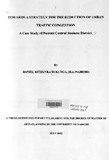| dc.description.abstract | Traffic congestion refers to the incremental costs resulting from interference among road users.
These impacts are most severe during peak hours when traffic volumes approach a road's
capacity. The resulting congestion reduces mobility and increases drivers' stress, vehicle costs
and environmental pollution. Traffic congestion is considered one of the main urban
transportation problems with an estimated cost of approximately $100 billion annually in the
U.S., and comparable costs in other countries (TTI, 2001).
Urban traffic congestion in the Nairobi Central Business District (CBD) is a fast growing
phenomenon and it is a big challenge for the city planners, the city administrators and the
general residents of the city. Most of the trips generated in the suburbs and beyond seem to be
directed to or through the CBD of Nairobi. Many factors, such as the clustered land uses, in
terms of location of utilities and functional arrangements contribute towards this problem. The
urban traffic congestion, if ignored can grow to become a nightmare in the entry into, and exit
out of the main service areas of the CBD of Nairobi especially in the morning and in the evening
peak hours.
The traffic congestion on the main channels of mobility brings about slow speed, infrequent and
irregular runs, unreliable schedules, poor riding comfort, uncertain arrival times, delays, long
waiting on the road, long waiting at the bus stops, crowded vehicles which leads to
psychological and emotional stress and frustrations to the passengers, drivers and other roads
users. All these are the consequences of unethical human behaviour coupled by poor urban
traffic management with laxity and inadequate traffic management policy enforcement in the
city enhanced by obsolete and inadequate transport systems in the CBD of Nairobi. The idle
running petrol or diesel engines of the stationary vehicles in the traffic congestion emits raw
fumes, which are high damaging to the general environment.
This study attempted to understand the causes of urban traffic congestion on the roads leading
into and out of the CBD at peak hours with special reference to any motor vehicle driver in the
CBD and the NMT as the principle means of transport in Nairobi. The study considered the
Nairobi area traffic police and the city council of Nairobi as the main traffic managers in the city
on a daily basis. The objective of this study was to develop a strategy towards the reduction of
urban traffic congestion to decongest the CBD of Nairobi with a view to suggesting ways to
improve the quality of the speed of mobility within the CBD and suggest ways of optimising the
use of the existing meagre traffic facilities within the city at a larger extent. Different research
techniques were applied. These included focus group discussions, informal interviews aided by
questionnaires, scheduled interviews with stakeholders, mapping, literature review, photography
and physical observations in the field.
The lack of traffic segregation system in the CBD of Nairobi means that the non-motorized users
who include pedestrians, hand carts, animal drawn carts and bicycles as well as wheel chairs and
wheel barrows, which move very slowly, have to share the same urban streets with buses, trucks,
mini buses and cars. The electronic urban traffic congestion management signals installed in the
late 1960's and early 1970's are either vandalised, non-functional or obsolete and are not
synchronised to allow a fast flow of motorised traffic up or down the city centre streets.
The clustered urban land use in the CBD of Nairobi with centralised services attracts and
generates a lot of traffic per hour, causing most of the trips generated in the Nairobi area and
beyond to be directed at the CBD
The human behaviour and negative attitudes indicated that the unruly public transport operators,
especially the matatu drivers block the city centre streets at will, whenever they are picking or
dropping passengers sometimes at undesignated spots on the road.
The recommended strategies need to be applied in combination (e.g. congestion pricing, traffic
restraint, Teleworking, ring roads around the CBD etc) because a particular strategy may be
highly effective in one situation but provides no benefit in other situations. Traffic planning
models are used to predict the impacts of congestion reduce strategies. | en_US |

